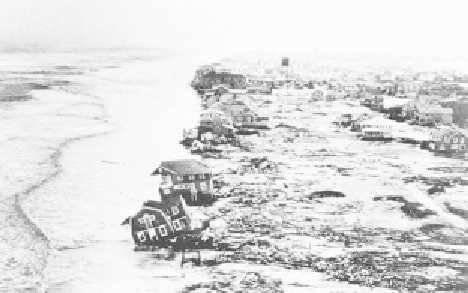Geoscience Reference
In-Depth Information
speeds of 120 km hr
-1
and waves reached heights of
12 m. Storm conditions extended along the coast from
North Carolina to Nova Scotia on a storm surge
exceeding 2 m. This surge had been exceeded only
during the Great Atlantic Hurricane of 1944 and the
nor'-easter of March 1962. For hundreds of kilometers
of coastline, sea walls, boardwalks, piers, and homes
were reduced to rubble. Inland, high winds downed
communication infrastructure, tore out trees, and blew
roofs off buildings. Finally, in one last twist, the center
of the storm passed over the warm Gulf Stream and
acquired the characteristics of a hurricane.
Storm damage produced by the Ash Wednesday storm of
7 March 1962 along the mid-Atlantic United States coast.
Fig. 3.17
Australian east-coast storms of May-June 1974
However, this value varied considerably over short
distances. The Ash Wednesday storm represented a
turning point for coastal geomorphology and engineer-
ing in the United States. Afterwards, the federal
government made research into coastal erosion and
beach processes a priority. Since then, the concept of
a coastal setback line has been developed and
implemented in some states. This setback line is based
on the probability, derived from historical evidence, of
coastal flooding or erosion. Building development is pro-
hibited seaward of the line, with the legality of such a
prohibition being tested and upheld in the courts, specif-
ically in North Carolina, where established insurance
companies now will not insure buildings against wave
damage if they are built seaward of the
setback line
.
(Bryant & Kidd, 1975; Bryant, 1983)
East-coast lows off the Australian coast are as intense
as tropical cyclones. However, the three May-June
storms of 1974, while mainly confined to New South
Wales, remain the most significant and widespread
series of such lows to strike the east coast of Australia
in 100 years. Each storm event consisted of a classic
east-coast low that developed along the western edge
of the Tasman Sea over warm pools of water. In each
case, blocking highs over south-eastern Australia
exacerbated the duration of the storms by directing
south-east winds onto the coast for several days.
Figure 3.18 presents the wave heights generated by
the three storms and the elevation of the associated
storm surge as shown by the difference between actual
and predicted tide heights. Maximum wave heights
reached 7 m on 25 May and again on 12 June. For most
of the three weeks, wave heights were above 4 m. For
the whole period, tide levels exceeded predicted ones,
with the greatest deviation being 0.7-0.8 m during the
25 May storm. This is the highest recorded surge along
the New South Wales coast. In embayments, this surge
was accompanied by seiching and wave
set-up
such
that water levels at the peak of each storm did not
fall towards low tide but kept rising. In Sydney, many
homes built close to the shoreline were threatened;
however, only a few homes were destroyed (Figure
3.19). The sandy coastline suffered the greatest
damage. In the three-month period from April to June,
Stanwell Park beach high tide line retreated over
100 m. At Pearl Beach in Broken Bay, north of Sydney,
a dune 7 m in height was overtopped by storm waves.
Measured shoreline retreat amounted to 40 m on some
beaches (Figure 2.11). During the third storm,
Cudmirrah Beach south of Jervis Bay underwent dune
The Halloween storm of October 1991
(The Perfect Storm)
(McCowan, 2001)
The Halloween storm of October 1991 was comparable
to the Ash Wednesday storm. It began with the passage
of an intense cold front preceding a mobile polar high
that swept across warm seas off the north-east coast of
the United States. In North America, these east coast
lows are called 'nor'-easters'. The low intensified off
Nova Scotia in the late evening of 28 October 1991. So
strong was this extra-tropical low that Hurricane Grace,
which had formed on 27 October and was moving
northward along the east coast of the United States,
swung dramatically towards the storm. Grace was
already producing waves 3-5 m high. Grace merged
with the low, which continued to deepen to a central
pressure of 972 hPa by midday on 30 October, backed
by a high-pressure cell with a central pressure of
1043 hPa. Within the next 24 hours, winds reached










